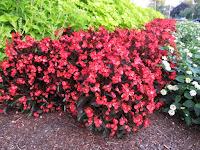| Whopper Rose/green leaf |
 |
| 'Big Red Begonia/bronze leaf |
Wax begonias (Begonia x semperflorens) are popular summer annuals in flower gardens and containers. Over the last few years new interspecific hybrids have changed how we garden with wax begonias.
Hybrid begonias bloom non-stop for almost six months (mid-May thru October (USDA hardiness zones 6 and 7). Plants stand up to summer heat, humidity, and dry spells, and the foliage stays mostly pest and disease free.
Plants grow vigorously, 18 to 24 inches tall and wide by the late summer/early fall. This means fewer plants to purchase to fill the garden space which will save you money. Space hybrid begonias around 15-18 inches apart depending on which of the three series that you plant.
Hybrids boast larger and showier flowers than the traditional wax begonias. Flower size varies from 2 to 3 inches across. The brightly colored blooms are visited by many kinds of butterflies over the long bloom season. Flowers are self-cleaning and require no deadheading. Plants are compact and well-branched.
Bronze-leaf types grow best in full sun, and green leaf cultivars thrive in partial shade.
Begonias need a well-drained soil with lots of well-rotted compost added. Green leaf types tend to scorch under intense sun.
They perform best with moderate fertility and are not heavy feeders. At spring planting, feed with a slow-release fertilizer such as Osmocote™ 14-14-14 or Nutricote™ 13-13-13. Add 1 to 2 feedings in mid-summer with a water-soluble fertilizer (such as Miracle-Gro®, Schultz®, or Jacks®) southern climates (zones 6-9).
Add 2 to 3 inches of mulch for weed suppression and to conserve soil moisture. Irrigate during extreme dry spells to maintain plant vigor, and flower numbers.
Intersspecific
Hybrids Begonia Cultivars:
Big™ series are available in bronze-leaf (full sun) and green leaf (part sun) forms; flower color choices are red, rose and pink.
Whopper™ series come in red and rose colors only and are available in bronze-leaf and green leaf types. Whopper plants tend to grow 20-25% larger than Big.
Megawatt™ series. Current varieties include 'Red Green Leaf', 'Pink Bronze Leaf', 'Rose Green Leaf', 'Red Bronze Leaf' and 'Rose Bronze Leaf'; new color choices will be added in 2018.
